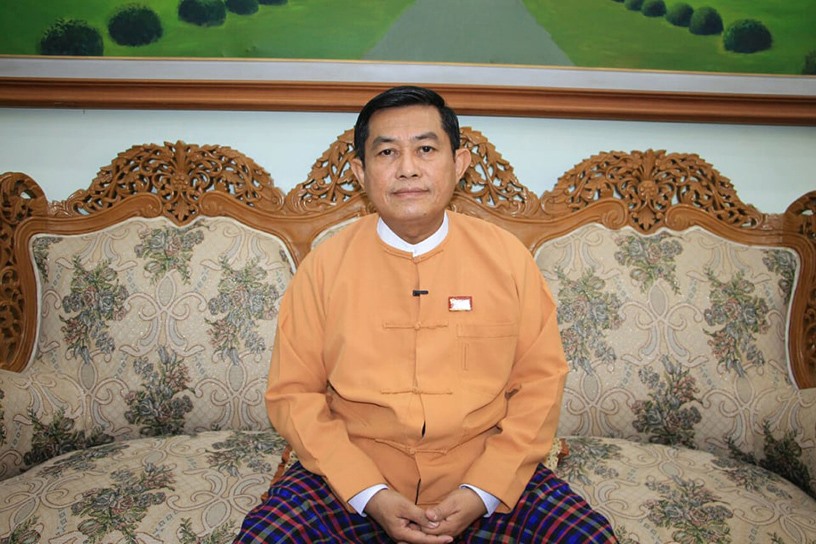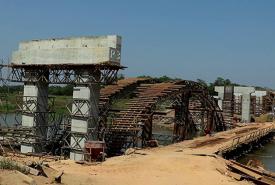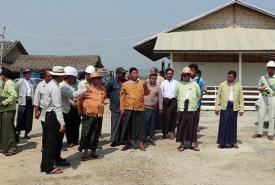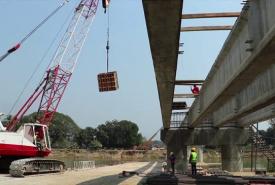18 May
By Thi Thi Min
Photo: Tin Soe (Bago)
In our fourth year, we focused on developing various sectors contributing towards national and socioeconomic development by incorporating community-based measures and inclusiveness in our strategies for equal development across the urban and rural areas : U Win Thein (Bago Region Chief Minister)
From the moment they assumed office, the Bago Region government has been working hard to drive public socioeconomic development by improving agricultural systems, forming industrial zones, generating or acquiring sufficient electricity, and promoting tourism. In addition, they are continually finding ways to attract more investment, from both domestic and foreign sources, into the region so as to increase individual income for all citizens and create more employment opportunities.
The following is an interview with Bago Region Chief Minister U Win Thein on their fourth year in office since the civilian government took over administration, asking him about their accomplishments, challenges, and plans moving forward.
Q: Could you tell us what policies you have implemented to drive up development in Bago Region?
A: We have 12 policies in place: (1) generating more electricity and developing infrastructure and urban-rural areas, (2) the agricultural and livestock sector, (3) developing the industrial sector and SMES, (4) emergence of special economic zones, (5) developing human resources, (6) developing trade, (7) better land, forestry and natural resource management, (8) promoting regional public services, (9) environmental conservation and developing tourism based on the natural environment, (10) ensuring accurate and systematic tax collection, (11) proper administration, rule of law, and abolishing corruption, and (12) increasing cooperation with all stakeholders.
But I hope to talk more about the processes that were in play rather than policies in our one-year performance. We are incorporating policies enacted by the union government and especially directives for attaining certain development goals by 2030. We add that together with our regional Hluttaw and work from there.
In our fourth year, we focused on developing various sectors contributing towards national and socioeconomic development by incorporating community-based measures and inclusiveness in our strategies for equal development across the urban and rural areas. We have annual projects that set an overall arching time frame for accomplishing these goals.
Q: What forms of cooperation with the executive pillar has been noteworthy or remarkable?
A: We formed the regional Ministry of Immigration and Human Resources, in line with the State Counsellor’s guidelines, to develop society both physically and mentally. This will lead to the formation of a skilled labour force. We have also expanded human resources into developing technical sectors.
There is a history of problems with administration officers, especially from the ward administrators at the most basic level, in these region. We could even say issues with expenditures and administration processes begin from villages, depending on how their administrative structure.
Thus, we try to upgrade the skills and capabilities of village and ward administrators. From checking accounts to compiling them, allotting funds for things like the electric sector or constructing roads and bridges, how to cooperate in the planning phase of projects, and land management.
So, we have been organizing these training programmes and cooperation at the district and township levels for implementation.
To encourage good democratic practices, we have organized numerous meetings with the members of the public and prioritized awareness raising campaigns. We also negotiated to resolve matters submitted by local residents.
Q: What did you cooperate on with the judicial pillar?
A: We opened community-centered legal support units in 28 townships to ensure the integrity of the judicial pillar. They provide legal consultation and help people with either financial difficulties or insufficient legal knowledge better understand the law. Each court of law also has an information counter and a media room where a Court Information Officer (CIO) facilitates information to the media.
We prioritize the prevention of the 10 major types of crimes, especially the area of illegal drugs where we have apprehended 236 suspects so far. We have also organized over 180 lectures on the subject.
Q: What have you cooperated on with the legislative pillar?
A: We have opened legislative support offices in 28 townships within the region and I want to say they have been immensely helpful for the public at large. Certain laws like land tax laws or colonial laws would have tax levied at K2 or K3, amounts no longer relevant to present times. We have petitioned to the President to amend them and will cooperate with Hluttaw representatives to designate appropriate tax amounts.
Q: What did you do to develop the agricultural sector?
A: We are in the process of forming a joint-venture agricultural system. This intends for the farmers who are mostly working individually to become more cooperative and work together. The cooperative agricultural law will help farmers understand the collaboration between financial institutions giving out loans, agricultural experts, and international marketing processes.
We are also in the middle of amending the fisheries law to properly implement fishery development in down to the lake and breeding farm level.
We pay close attention to land issues directed by the President’s office. Land is closely related to the source of most issues and that’s why we have formed a committee dedicated solely to resolve these issues.
Q: What did you do to ensure better infrastructure within the region to boost development, including rural areas?
A: Within this year, we have paved about 105 miles of concrete roads, 136 miles of gravel roads, 148 miles of laterite roads, 52 miles of dirt roads, and constructed 160 rural bridges and 133 other bridges, measuring 1,204 feet. In Bago Region, there are the Ottwin-Paukkaung and Minhla-Pado roads connecting the two sides of the region separated by the Bago Yoma. There is the Targara road connecting us to Magway Region. The closest town to Bago is Thayawady but the roads connecting to it are in poor condition. Hence, we are constructing a direct road between the two locations. By expanding about 30 miles of the road from Thayawady we can connect it directly to Bago.
We are also in the final stages of paving roads connecting to Kayin State and Kayah State, crossing over the Sittaung River, joining with Yedashe and Toungoo townships and even directly connecting to Thailand. The Ottwin-Htantabin Bridge, Shwegyin Creek Bridge, Kawa Bridge and Thameinbayan Bridge located south of Bago are included in development projects. Once these bridges are complete, regional socioeconomic situations and tourism will noticeably increase.
Q: What about the electric sector, access to drinking water and rural development?
A: Providing electricity to villages is an important task, so we’ve implemented solar-power systems in villages are about 10 to 11 miles from the national power grid, or just too far from national power sources. So far, we have successfully implemented this in 15 villages and provided solar powered electricity to 527 households.
The electric sector is very important and there is the national objective of achieving complete electrification across the entire nation by 2030. In that regard, we have completed the 33KVA (12 mile) transmission line in Zaungtu village and the 33KV (14.5 mile) line in Tanatpin-Kawa. We are in the middle of constructing a 33/11KV 5MVA sub-power station in Kawa, a 33/11KVA (12 mile) line in Mone, an 11KV (72.99 mile) line, 400V (42.032 mile) line, and 90 transformers.
With regard to the National Electrification Project (NEP)’s 2-mile plan, we have successfully implemented 2,410 solar power systems in 1,460 villages using loans from the World Bank. We were able to provide electricity to 12 villages in the NEP’s 2-mile range, a village in the 5-mile range, and six villages in the ranges above 5 miles. We have dug up 330 wells for rural drinking water.
Bago Region started working on construction processes with an annual budget of K160 billion and we have since been allotted up to K200 billion. We have formed the Bago Region Construction Board (BRCB) as a sort of third organization to oversee construction processes in the region and ensure they meet deadlines and designated standards.
Q: What have you accomplished in the health sector?
A: We have constructed 3 16-bedded traditional medicine hospitals, a traditional medicine department office, a 50-bedded hospital and 5 16-bedded hospitals across the region. Furthermore, the FDA performs surprise checks in markets, schools and restaurants using mobile labs.
Q: How have you developed the hotels and tourism sector?
A: We have began digging up the moat of the Kanbawzathadi Palace, which is over 500 years old. We are restoring the city walls to their original state. It’s a delicate task as they are over 500 years old, so there is a lot of collaboration between numerous departments and the public.
We are attempting to revive the pilgrimage process to Kyaikhteeyoe Pagoda in Shwegyin Township and it is showing promising results. We will uncover an ancient town in Kyaukkyi Township for tourism and transform the runway strip in Nanchun village used during the Second World War into a memory park. In addition, we are establishing private forests and also teaching locals how to craft bamboo and wooden accessories.
Q: How have you developed the agriculture and livestock sector?
A: We have began experimenting with organic farming in close contact with the FDA. We have resolved 125 land disputes out of 192 reported cases. That’s why we will soon resolve the land disputes. We will soon implement napier grass plantations for livestock grazing and contract farm systems as well.
Q: What have you done to create more jobs for local residents?
A: We are encouraging SME development in the region and opening training courses for skilled labor. The Bago Region Investment Committee facilitates smooth processes for foreign investments, especially Chinese and western factory investments. We are supporting weaving businesses in Shwetaung, garment businesses in Pyu organized by the Ministry of Border Affairs, and food and beverage businesses until they can operate on their own.
Q: Tell us a bit about the investment sector.
A: There have been 83 foreign investments made in Bago Region with a combined about of USD1,584.666 million. We are implementing industrial plans near Kali village and Pyay, residential projects, and town plans.
Q: What about protecting against natural disasters?
A: The regional government has used K1,000 million in funds for Sittaung River bank erosion along Indaing-Hnawpin village in Htantabin and Yedashe townships. The union government funded the construction of 175 houses in Kyuntawsu village after the spillage from Swar dam and an additional 19 houses in Swar Min Lan village.
Q: Is there anything you would like to add?
A: The regional government is putting in all of its efforts in preventing, containing and treating COVID-19 during these trying times. We have opened facility quarantine centers for Myanmar nationals returning from China and Thailand and also opened community fever clinics. People coming in from other states and regions are given medical examinations in Bago or Waw.
I would like to urge to public to remain in their homes to limit the spread of the virus and to wear masks and follow proper conduct if they must venture outside. Please wash your hands frequently and closely follow government health guidelines to ensure the safety of the community from the virus. (Translated by Pen Dali)







